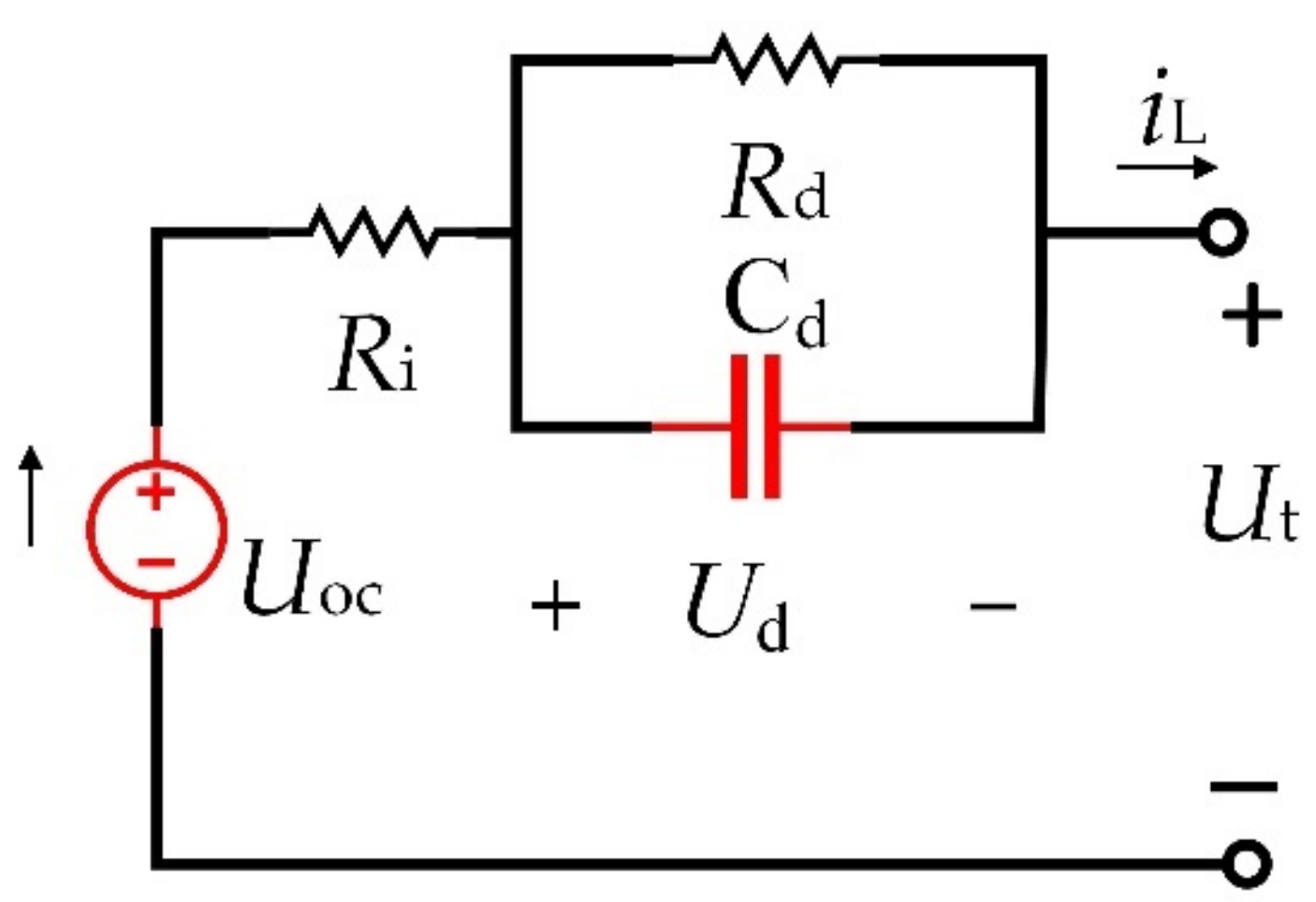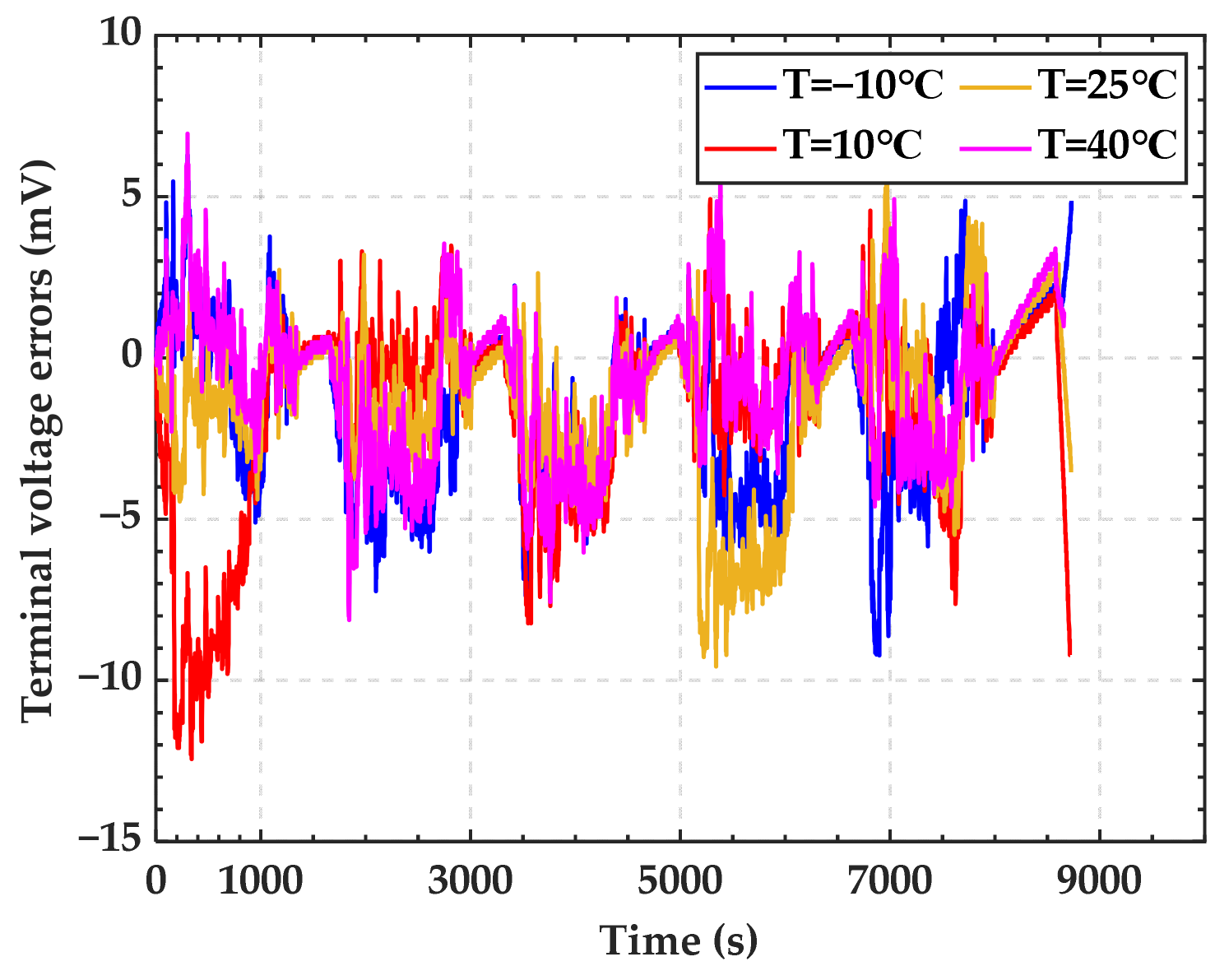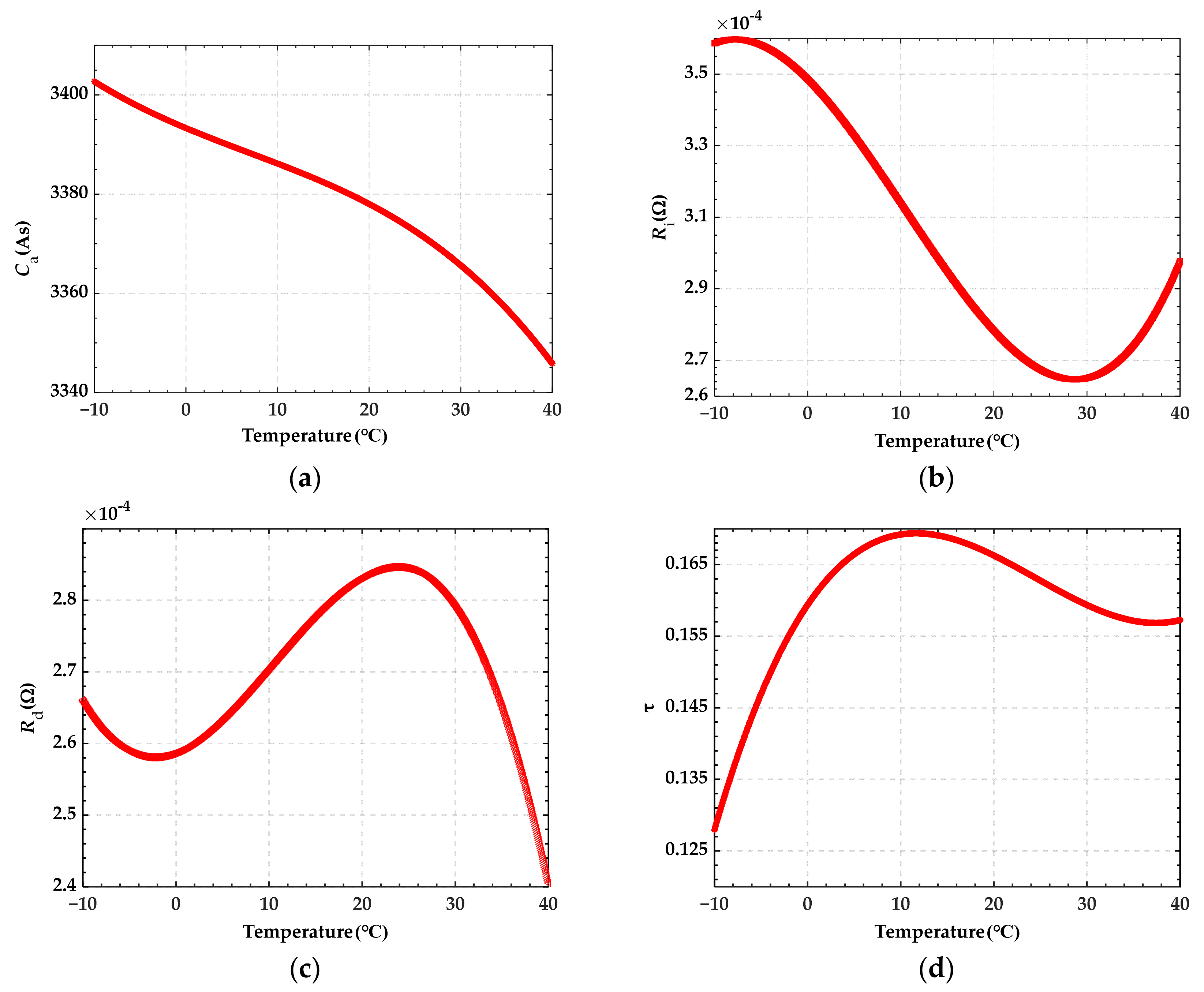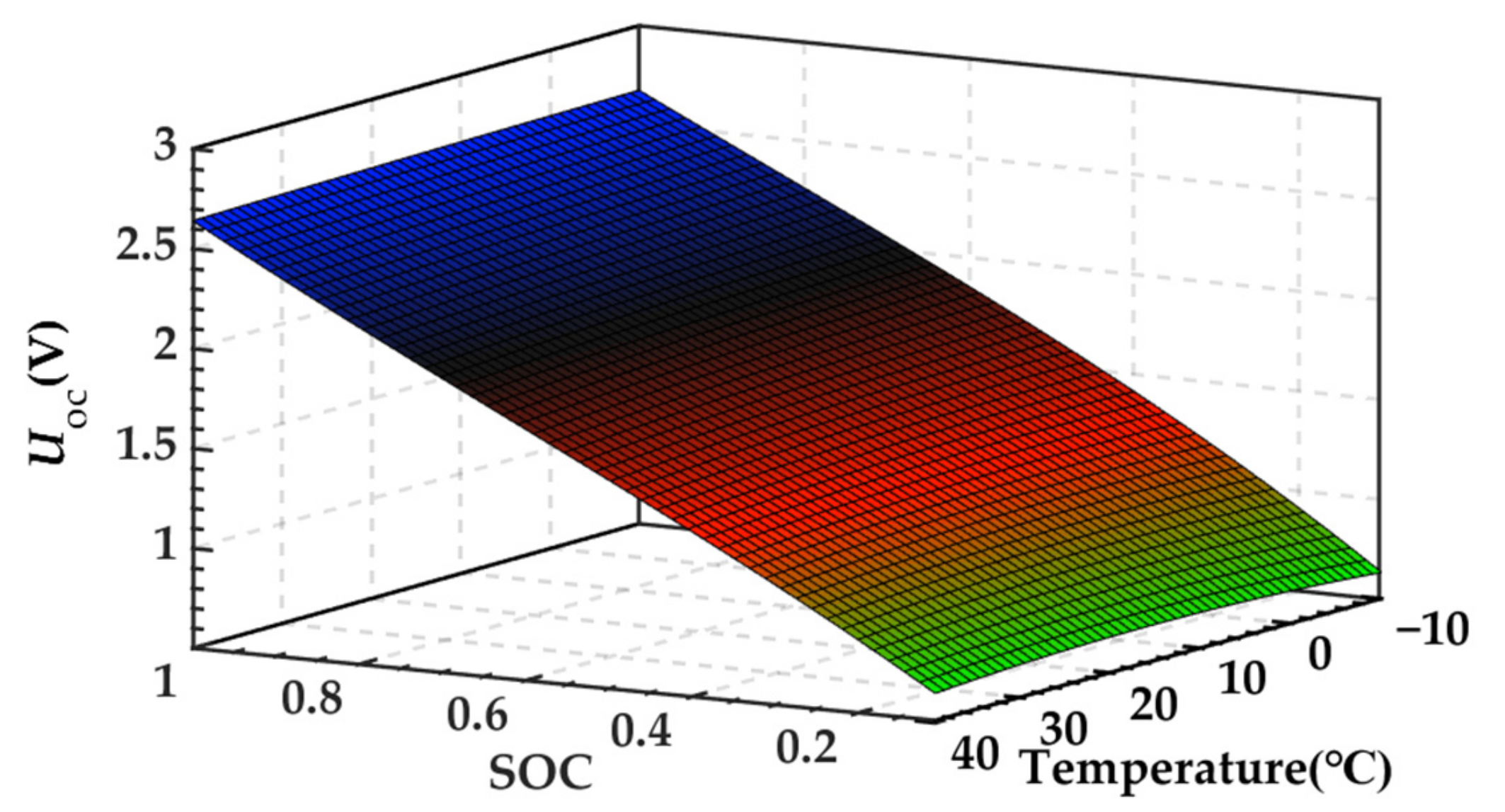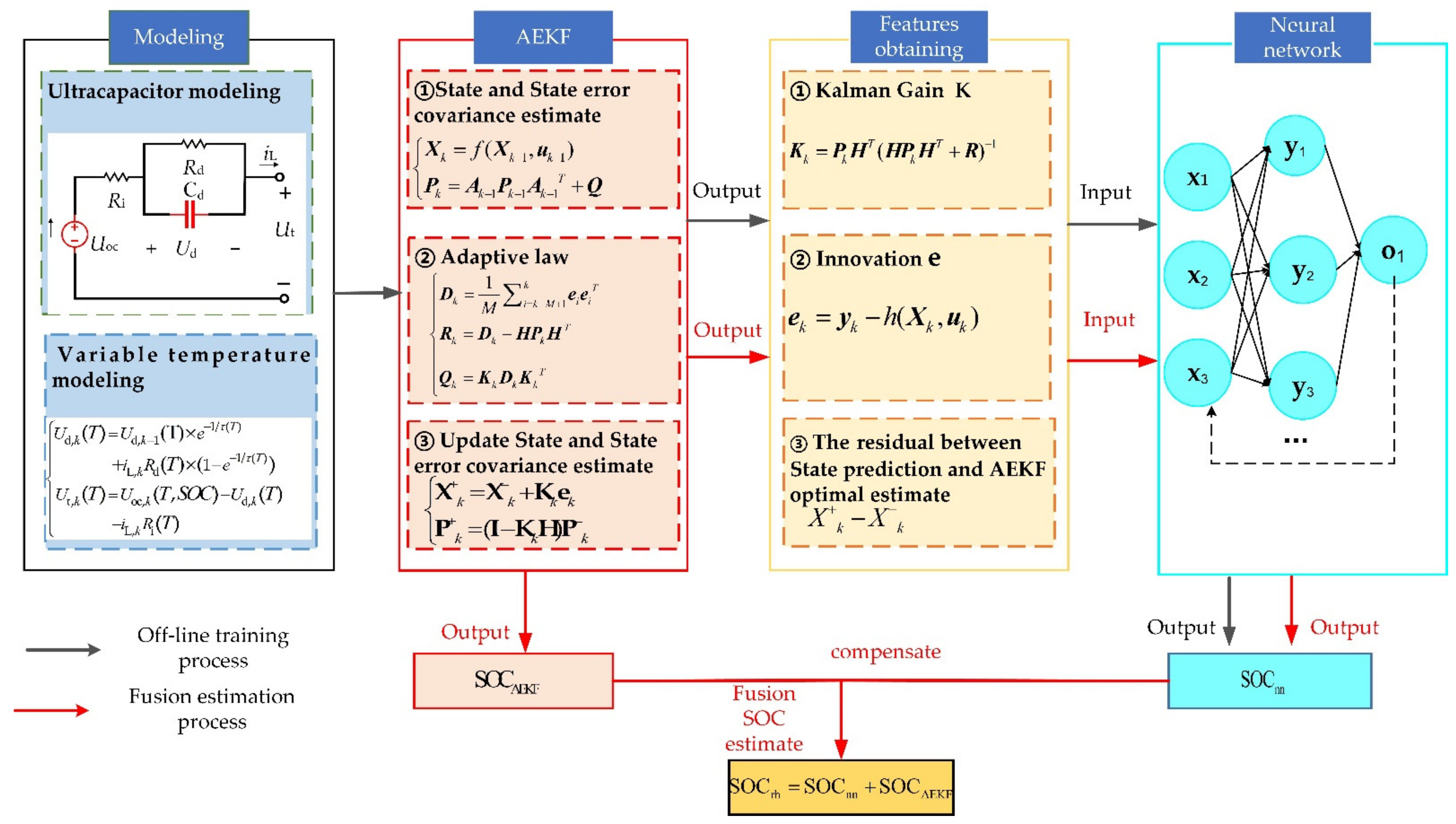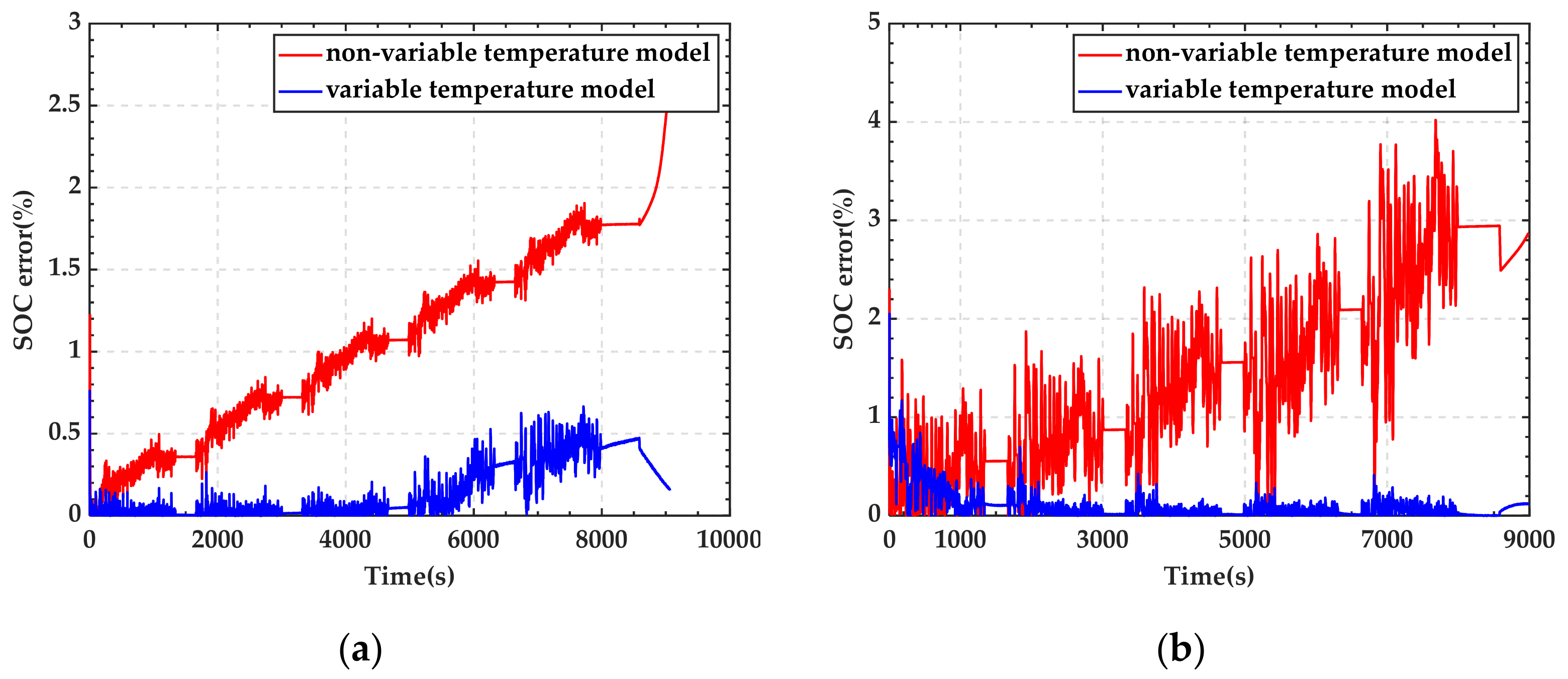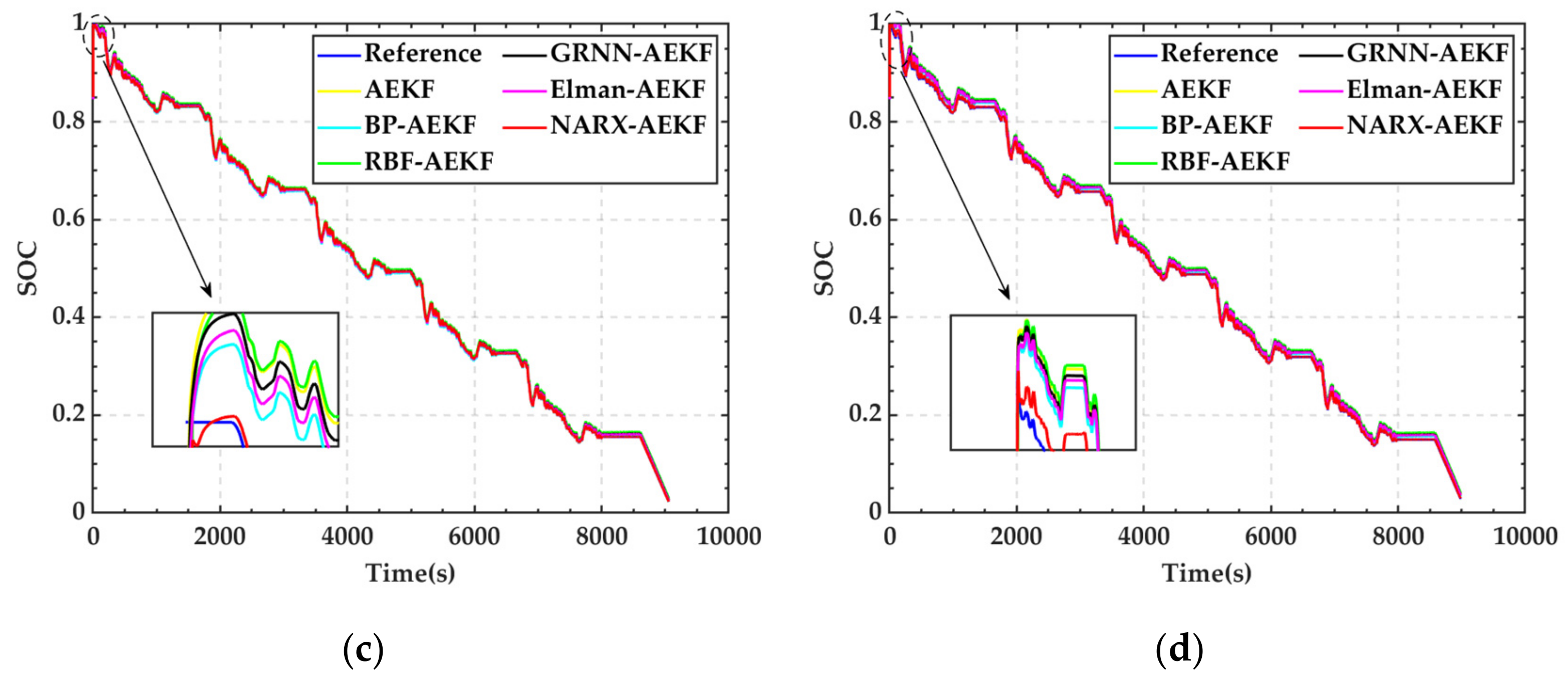1. Introduction
Due to the deterioration of environmental pollution and energy shortage in the world, the development of electric vehicles has received extensive attention since its high efficiency, low noise and no pollution [
1,
2]. At present, the power source technology is still one of the significant factors restricting the rapid development of electric vehicles [
3]. Meanwhile, the ultracapacitors are selected as new energy storage device and gradually applied in auxiliary power source of electric vehicles for its ultrahigh power density, long-term cycle life and excellent safety [
4,
5]. The State-of-Charge (SOC) indicates the current available capacitance, which is considered as a crucial state parameter of ultracapacitor. It is well known that the variable temperature environment has an unavoidable effect on the SOC estimation accuracy [
6,
7]. The conventional SOC estimation methods generally divided into coulomb counting method, characterization parameter method, data driven based method and model based filter method [
8].
Coulomb counting method is also known as the Ampere-hour method, which is the most popular and simplest SOC estimation method [
9]. However, due to the accumulation of current measurement errors, it is usually used for short time prediction or combined with other methods to estimate SOC [
10]. The coulomb counting method can obtain the SOC by measuring and integrating the current while the value is susceptible to the current measurement errors, reducing accuracy. In addition, the open circuit voltage (OCV) is one of the important parameters of SOC estimation. Meanwhile, the OCV-SOC curve has good linear characteristic under certain conditions. Therefore, the SOC estimation can be indirectly realized by obtaining the open circuit voltage value [
11,
12,
13]. The characterization parameter method has the great realizability and can correct the cumulative errors. Yet, the method is reliant on the accuracy of the curve between parameter and SOC, and it is subjection to the uncertain factors. The neural network method is known as a typical data-driven based method, which can obtain the mapping relationship between the parameters and SOC. It also can be applied to estimate SOC [
14,
15,
16,
17]. In general, the network training process is concomitant with abnormal phenomenon, such as voltage overfitting. A time-delay recurrent neural network proposed by Xi et al. can improve the SOC estimation accuracy by identifying and eliminating overexcited neurons [
18]. To promote the SOC estimation accuracy, Zhang et al. utilized the particle swarm optimization algorithm to update the neural network [
19]. However, the methods require coping with a mass of data for training the network. How to accurately obtain the ultracapacitor SOC with a small amount of data is a challenge and little research has been carried out. Therefore, Weigert et al. estimated the composite power system SOC from the voltage data of a short initial period, and then obtained the ultracapacitor SOC [
20]. In summary, the estimation methods based on the neural network can accurately mining data characteristics. However, the neural network needs to have enough and effective training data and optimal parameters to obtain a better estimation effect. Thus, it is difficult for a single neural network to adapt to the dynamic changing process of ultracapacitor states and realize the applicability of ultracapacitor SOC estimation. The model-based filter method is widely used in SOC estimation for the advantages of self-correction ability and insensitivity to initial SOC. The selection of model and filter is significant for accurate SOC estimation. Wei et al. utilized extended Kalman filter (EKF) algorithm to estimate SOC at different time scales based on equivalent circuit model [
21]. The inappropriate filter preset parameters and linearization of EKF nonlinear function may lead to unstable accuracy. Therefore, the references [
22,
23] proposed unscented Kalman filter (UKF) to estimated SOC, which can overcome the above-mentioned shortcoming of EKF. However, the robustness of UKF is affected by the system noises. Thus Xiong, R.et al., designed a dual estimator framework including recursive least squares and adaptive H-infinite filter to promote the estimation efficiency [
24]. Similarly, the research based on the model and filter observers are also reported in [
25,
26,
27,
28,
29]. In summary, the method is provided with strong robustness, but the estimation performance highly relies on the accuracy of the model and preset matrixes.
In view of the characteristics of the methods based on neural network and model-based filtering methods, the combination of them to carry out SOC estimation research has attracted more and more attention. Tian et al. proposed a SOC fusion estimation method to update the estimation accuracy based on the deep neural network and Klman filter [
30]. The simulation results illustrate that the method still remains a root mean square error within 4% in the case of remarkable disturbances. The temperature has an unavoidable effect on the dynamic characterization of ultracapacitor, while the above estimation methods do not consider the temperature factor. Hence, Zhang et al. took the temperature into account and combined with the OCV-SOC curve to estimate SOC [
31]. In addition, a combination of nonlinear model and EKF is proposed by Chiang et al. to estimate ultracapacitor SOC, and the model is composed of thermal model and equivalent circuit model [
32]. Furthermore, the robustness and applicability of the previous methods at different temperatures are not sufficiently studied. A co-estimation model based on NARX neural network was proposed by Wang et al. to estimate SOC. The experimental results showed that the maximum RMSE of the model is 0.85% [
17]. In addition, the NARX was also employed to predict the state of health or temperature for its natures of mining nonlinear mapping relationship and robustness to dynamic characteristics [
33,
34]. The AEKF was widely applied in SOC estimation [
35,
36,
37]. The simulation results showed the algorithm has strong anti-interference to the uncertainties such as noises and initial error. The reasons why the NARX-AEKF would be beneficial to estimation of SOC are introduced as follows. On the one hand, the NARX is popularly used in time series forecasting and it is able to fast search the mapping relationship between filter parameters and SOC. On the other hand, the AEKF is equipped with the character of adaptive updating. Moreover, the compensation of NARX can narrow the gap of referred SOC and AEKF-estimated SOC. The SOC estimation accuracy can be improved to a certain extent. Thus, a combination method between NARX and AEKF is proposed to estimate ultracapacitor SOC.
A key contribution of this paper is that a high-performance ultracapacitor SOC fusion estimation method under variable temperature environment is proposed. The method not only overcomes the disadvantage of unstable accuracy in OCV-SOC method, but also deals with the problem of over-reliance on the accuracy of the initial SOC value in Ampere-hour method. Meanwhile, a novel SOC fusion estimation framework of neural network and Kalman filter algorithm is presented, and it makes full use of the Nonlinear Auto-Regressive Model with Exogenous Inputs (NARX) to compensate the adaptive extended Kalman filter (AEKF) estimation. Next, in order to improve the adaptability at different temperatures, a high-precision variable temperature ultracapacitor model is established based on the Thevenin model. Moreover, the accuracy of the proposed variable temperature model and SOC fusion estimation method is systematically evaluated at different temperatures.
The main contents of this paper can be summarized as follows: the first part describes the ultracapacitor model selection and the model parameter identification; the ultracapacitor SOC estimation method based on NARX-AEKF is depicted in the second part; the comparison and evaluation of six typical SOC estimation methods is presented in the third part; finally, the fourth part draws conclusions.
5. Conclusions
In this paper, an ultracapacitor SOC estimation method based on NARX neural network and AEKF in variable temperature environment is proposed. Firstly, Based on Thevenin model, the influence of temperature is considered, and a high-precision variable temperature model is established with the experimental data of ultracapacitor at different temperatures. Secondly, the SOC estimation results between NARX-AEKF with the non-variable and variable temperature model are compared and analyzed. Moreover, the results illustrate that the SOC fusion estimation method with variable temperature model has higher accuracy. The ME, MAE and RMSE are decreased by 71.012%, 93.654% and 90.187%, respectively., Thirdly, the estimation results of different SOC fusion estimation methods at different temperatures without initial error and when the initial error is 0.150 are compared.
Finally, the results show that the accuracy of NARX-AEKF fusion method is lower than other estimation methods without considering the initial error of SOC at −10 °C, but the ME, MAE and RMSE are reduced by 82.708%, 92.855% and 89.547% at the other three temperatures, respectively. The SOC estimation accuracy of NARX-AEKF with initial SOC error is the highest at all temperatures (−10 °C, 10 °C, 25 °C and 40 °C), and the ME, MAE and RMSE are 1.145%, 0.087% and 0.221%. The proposed method utilizes NARX neural network to compensate the AEKF estimation. In turn, the influence of noise is reduced, and the SOC estimation accuracy is effectively enhanced. At the same time, the accuracy and applicability of the NARX-AEKF in wide temperature environment is improved for the application of variable temperature model.
